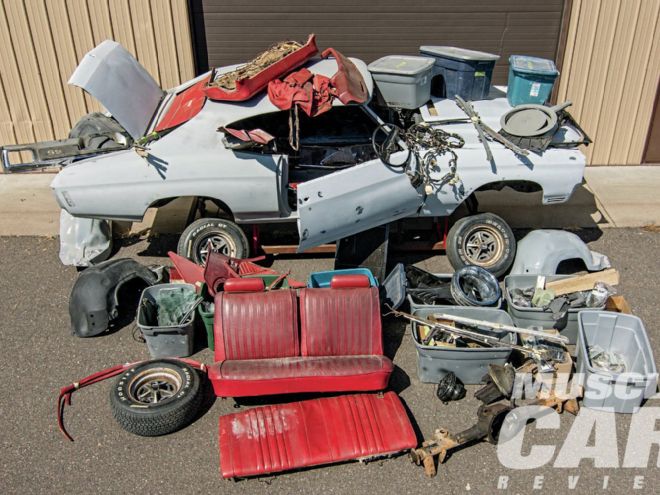
The temptation is very real. You are at a swap meet and there it is, the car you’ve always dreamed of owning. The price looks good. You have the money. True, it needs a little work. OK, it needs a lot of work. Actually, it’s a total basket case.
Still, in your mind’s eye, you can see it finished and how good it will look as you cruise the boulevard. Your mind starts calculating (read rationalizing) how much time it will take to complete, how much it will cost, and whether you, with some assumed help from your buddies, can really do this. You’re starting to feel a little excited about the prospect. You’re justifying the amount of work it needs by how much money you are going to save and because you’ll get to build it the way you want it.
Stop!
Now, we’re not telling you not to do it. But get out of your fantasy and think clearly about the car. It could be the deal of a lifetime or the automotive nightmare of your life. How do you tell the difference?
To answer that question, we went to someone with a lot of experience turning basket cases into world-class restorations: John Balow, owner of Muscle Car Restorations in Chippewa Falls, Wisconsin.
Balow and his team have, for more than 25 years, had cars delivered to their shop in every condition imaginable and certainly have seen more than their share of basket cases. The stories are as varied as the cars, but there are common pitfalls throughout.
This cannot be overstated. Do not, under any circumstances, allow yourself to get emotionally involved. It doesn’t matter how much you want this particular car. If the deal’s not right, walk away. The worst that can happen if you walk away is you miss out on a good deal. But picking up a bad one will cost you more time, money, and stress than you can imagine.
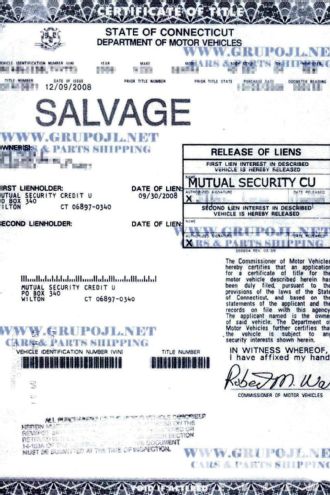 <strong>1</strong> If the title has a Salvage or similar designation, then the car has been considered totaled at some point. Don’t believe anyone who tells you that this designation can easily be removed or that it won’t be there when you get your new title. Buyers are rightly very leery of a salvage title, and it could cost you dearly when you try to sell it. Walk away and find a car with a clean title.
<strong>1</strong> If the title has a Salvage or similar designation, then the car has been considered totaled at some point. Don’t believe anyone who tells you that this designation can easily be removed or that it won’t be there when you get your new title. Buyers are rightly very leery of a salvage title, and it could cost you dearly when you try to sell it. Walk away and find a car with a clean title.
Don’t believe anything you are told about the car. You must be able to verify claims yourself. Determine on your own whether it is a good deal for you. That means you’ll have to do research before you can even think about making an offer (hence Rule 1). No impulse buying.
Balow has found that the phrase, “I’ve got everything you need to finish the car,” is never true. Also, never accept that a car in primer is “all ready for paint.” Primer can actually be a negative because there is no way to know what’s hiding under it. Balow has seen too many cars where body filler and primer have been used to cover up bad body work, rust, and more. Assume that you’ll need to strip it and start over.
2 Know how to locate the vehicle identification number (VIN) and any other code tags that pertain to the make you are looking at. Look for any evidence that the tags may have been removed at some point. Check that they match the title. You are looking for any sign of fraud and to verify any claims by the seller.">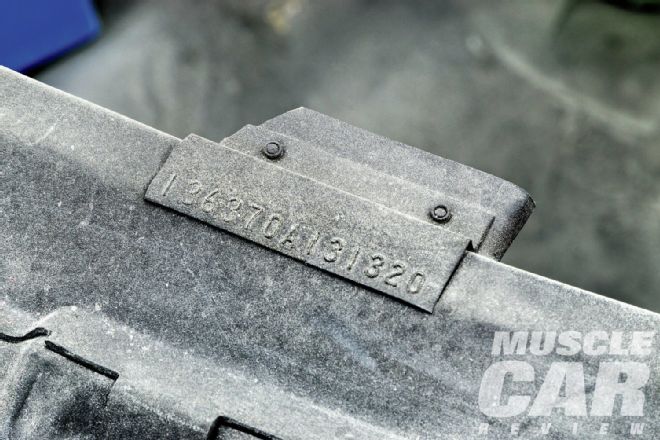 <strong>2</strong> Know how to locate the vehicle identification number (VIN) and any other code tags that pertain to the make you are looking at. Look for any evidence that the tags may have been removed at some point. Check that they match the title. You are looking for any sign of fraud and to verify any claims by the seller.
3 A thickness gauge is a good idea when examining any car, but especially one that is in primer. There are very few places on any car where it’s OK for body filler to be in excess of about an eighth of an inch.">
<strong>2</strong> Know how to locate the vehicle identification number (VIN) and any other code tags that pertain to the make you are looking at. Look for any evidence that the tags may have been removed at some point. Check that they match the title. You are looking for any sign of fraud and to verify any claims by the seller.
3 A thickness gauge is a good idea when examining any car, but especially one that is in primer. There are very few places on any car where it’s OK for body filler to be in excess of about an eighth of an inch.">
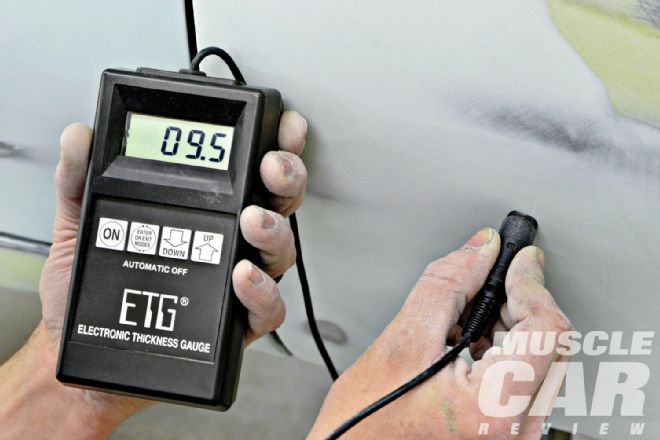 <strong>3</strong> A thickness gauge is a good idea when examining any car, but especially one that is in primer. There are very few places on any car where it’s OK for body filler to be in excess of about an eighth of an inch.
4 As a car is disassembled, all of the parts should be labeled, and the small parts should be bagged together. Keep in mind that not all of the parts that come with the car will be useable. If the parts are all just thrown in boxes, you’ll have to assume that a lot of them are missing and that it will take you considerable time to sort them out.">
<strong>3</strong> A thickness gauge is a good idea when examining any car, but especially one that is in primer. There are very few places on any car where it’s OK for body filler to be in excess of about an eighth of an inch.
4 As a car is disassembled, all of the parts should be labeled, and the small parts should be bagged together. Keep in mind that not all of the parts that come with the car will be useable. If the parts are all just thrown in boxes, you’ll have to assume that a lot of them are missing and that it will take you considerable time to sort them out.">
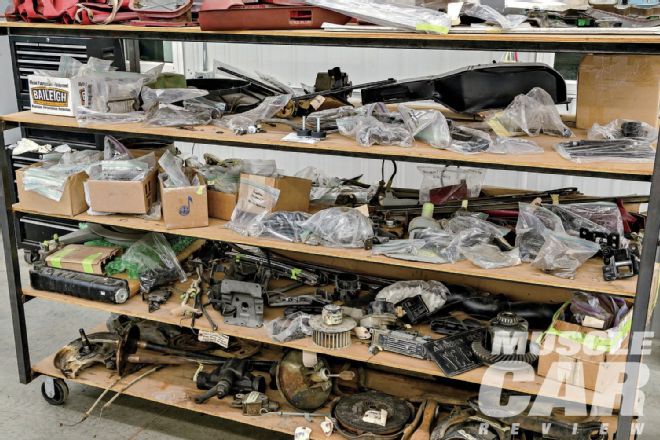 <strong>4</strong> As a car is disassembled, all of the parts should be labeled, and the small parts should be bagged together. Keep in mind that not all of the parts that come with the car will be useable. If the parts are all just thrown in boxes, you’ll have to assume that a lot of them are missing and that it will take you considerable time to sort them out.
<strong>4</strong> As a car is disassembled, all of the parts should be labeled, and the small parts should be bagged together. Keep in mind that not all of the parts that come with the car will be useable. If the parts are all just thrown in boxes, you’ll have to assume that a lot of them are missing and that it will take you considerable time to sort them out.
Know how to check and which numbers to check on a claimed numbers-matching car. Know how to check the VIN and tags to verify which model it really is and what it came with when new. It’s very easy to pass off a base model as a high-performance muscle car when it’s all apart. Also be sure to check the tag for any signs of removal and reinstallation, as that could be evidence of a rebody or, worse yet, outright fraud.
Never buy a car sight-unseen
Ask to see evidence to back up any claims about the car. If it’s supposed to be a rare one-of-X built, then you’ll need to see paperwork to back that up. Ask if there are photos of it before it was taken apart.
Never, for any reason, buy a car sight-unseen or just by photos. No matter how good the deal sounds or how good the photos look, you must put eyes on it (or send someone you trust) and do the proper research and verification. It is a good idea to ask the seller for more detailed photos of critical areas like VIN tags and such and to send copies of any papers that pertain. But think of these only as a help in determining if you want to go see the car in person.
5 There are literally thousands of small parts like these, many of which are fasteners you’ve likely never seen before. These are the easiest to lose and perhaps the most costly and time-consuming to replace.">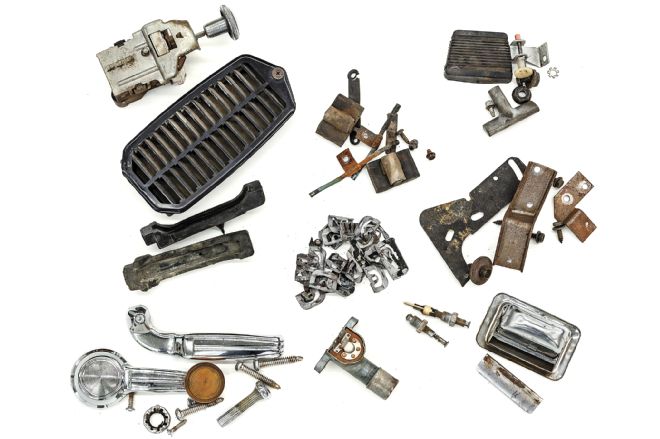 <strong>5</strong> There are literally thousands of small parts like these, many of which are fasteners you’ve likely never seen before. These are the easiest to lose and perhaps the most costly and time-consuming to replace.
6 These are a few of the essentials to bring when you inspect the vehicle. In particular, note the code books, thickness gauge, and camera. Use the code books to verify the vehicle’s true identity, the thickness gauge to check bodywork, and the camera to document anything you might want to show an expert later. ">
<strong>5</strong> There are literally thousands of small parts like these, many of which are fasteners you’ve likely never seen before. These are the easiest to lose and perhaps the most costly and time-consuming to replace.
6 These are a few of the essentials to bring when you inspect the vehicle. In particular, note the code books, thickness gauge, and camera. Use the code books to verify the vehicle’s true identity, the thickness gauge to check bodywork, and the camera to document anything you might want to show an expert later. ">
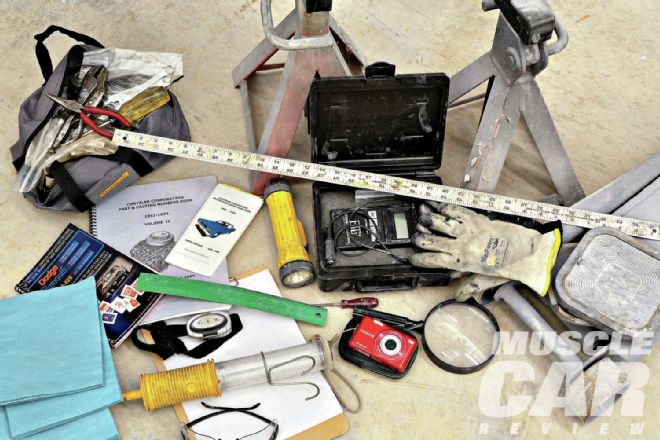 <strong>6</strong> These are a few of the essentials to bring when you inspect the vehicle. In particular, note the code books, thickness gauge, and camera. Use the code books to verify the vehicle’s true identity, the thickness gauge to check bodywork, and the camera to document anything you might want to show an expert later.
7 This is Muscle Car Restorations’ tool kit for picking up cars in all kinds of conditions. When you go to pick up your new project, give some thought to what you will need to properly load, secure, and haul it and all the boxes of parts. ">
<strong>6</strong> These are a few of the essentials to bring when you inspect the vehicle. In particular, note the code books, thickness gauge, and camera. Use the code books to verify the vehicle’s true identity, the thickness gauge to check bodywork, and the camera to document anything you might want to show an expert later.
7 This is Muscle Car Restorations’ tool kit for picking up cars in all kinds of conditions. When you go to pick up your new project, give some thought to what you will need to properly load, secure, and haul it and all the boxes of parts. ">
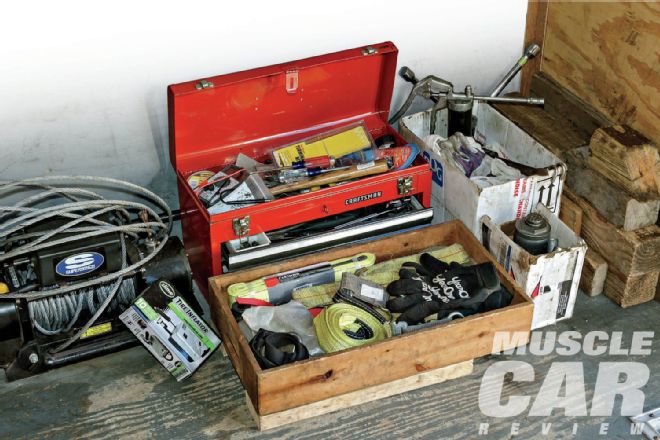 <strong>7</strong> This is Muscle Car Restorations’ tool kit for picking up cars in all kinds of conditions. When you go to pick up your new project, give some thought to what you will need to properly load, secure, and haul it and all the boxes of parts.
<strong>7</strong> This is Muscle Car Restorations’ tool kit for picking up cars in all kinds of conditions. When you go to pick up your new project, give some thought to what you will need to properly load, secure, and haul it and all the boxes of parts.
This one is an absolute. Verify that the VINs on the title and the car match. Titles from scrapped or abandoned cars have been used to sell a car without one. You don’t want that kind of legal mess.
If the deal’s not right, walk away
Check that the title is in the seller’s name. If it’s not, then he doesn’t legally own the car and is likely just trying to flip it. Insist that the legal owner accompany you to the DMV and only pay him or her when you are sure that everything is in order. You should also run a DMV/Carfax check to be sure you aren’t dealing with a stolen, totaled, or salvaged vehicle. Verify that your new title won’t have a salvage designation.
Try to find out as much history about the car as you can. Ask how long they have owned the car, or if they owned it before it came apart. Did they take it apart? Where was it stored? Has it been moved since it came apart? Questions like this should all provide valuable info. You can expect more parts to be missing if the car has been moved to a different location from where it was disassembled, or if the seller bought it from someone else (or a resto shop) who took it apart.
How organized is the seller? Are all the parts organized and labeled, or is everything just in a big pile? How much of the car is still together? There are literally thousands of small parts to account for, and short of doing a complete inventory--which would take days to do--it is impossible to know exactly what will be needed. Expect to have to locate and purchase more than you think.
8 During the initial inspection of this Chevelle, it was noted that this inner wheelwell was improperly welded to the floor. This could be clue to the quality of the work done to the rest of the car. ">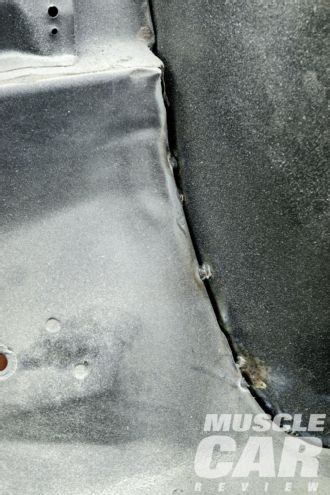 <strong>8</strong> During the initial inspection of this Chevelle, it was noted that this inner wheelwell was improperly welded to the floor. This could be clue to the quality of the work done to the rest of the car.
<strong>8</strong> During the initial inspection of this Chevelle, it was noted that this inner wheelwell was improperly welded to the floor. This could be clue to the quality of the work done to the rest of the car.
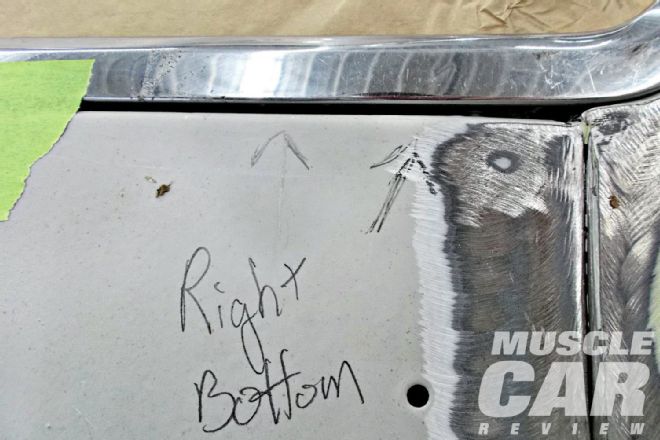 9 Both rear quarters were replaced, but both were fitted incorrectly, as these gaps around the lower rear window trim clearly show. This can only be fixed by cutting and reshaping the metal in these areas. ">
9 Both rear quarters were replaced, but both were fitted incorrectly, as these gaps around the lower rear window trim clearly show. This can only be fixed by cutting and reshaping the metal in these areas. ">
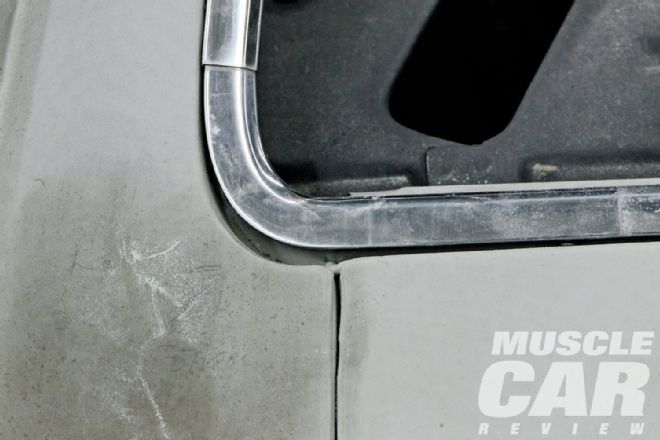 <strong>9</strong> Both rear quarters were replaced, but both were fitted incorrectly, as these gaps around the lower rear window trim clearly show. This can only be fixed by cutting and reshaping the metal in these areas.
10 The lower attachment points of this front fender were cut to allow it to bolt up. This is not correct, and you would want to find out why this was necessary. ">
<strong>9</strong> Both rear quarters were replaced, but both were fitted incorrectly, as these gaps around the lower rear window trim clearly show. This can only be fixed by cutting and reshaping the metal in these areas.
10 The lower attachment points of this front fender were cut to allow it to bolt up. This is not correct, and you would want to find out why this was necessary. ">
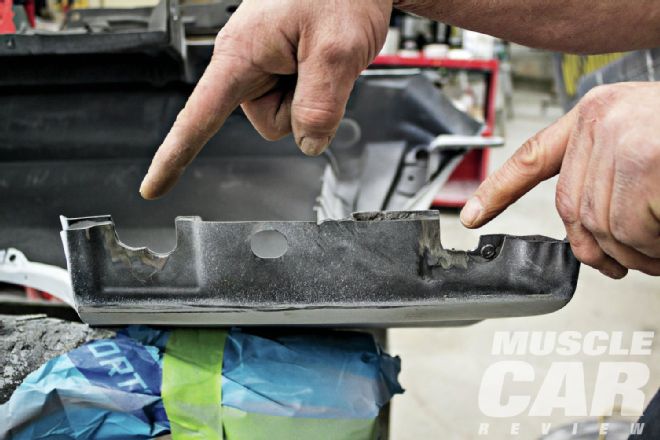 <strong>10</strong> The lower attachment points of this front fender were cut to allow it to bolt up. This is not correct, and you would want to find out why this was necessary.
11 When Muscle Car Restorations’ body techs mocked up the rear window and trim, they discovered that it didn’t fit in the upper left corner. Drawing a line around the trim shows where the edge of the trim falls, indicating how much the window opening is going to have to be moved to get the window and trim to fit correctly. This is the result of an incorrectly installed quarter-panel.">
<strong>10</strong> The lower attachment points of this front fender were cut to allow it to bolt up. This is not correct, and you would want to find out why this was necessary.
11 When Muscle Car Restorations’ body techs mocked up the rear window and trim, they discovered that it didn’t fit in the upper left corner. Drawing a line around the trim shows where the edge of the trim falls, indicating how much the window opening is going to have to be moved to get the window and trim to fit correctly. This is the result of an incorrectly installed quarter-panel.">
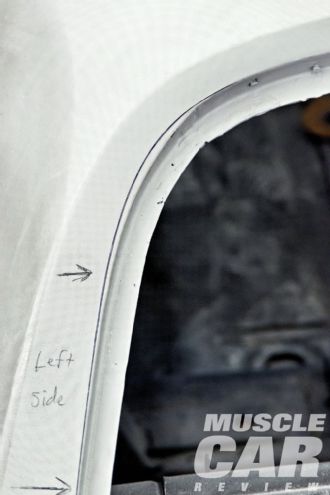 <strong>11</strong> When Muscle Car Restorations’ body techs mocked up the rear window and trim, they discovered that it didn’t fit in the upper left corner. Drawing a line around the trim shows where the edge of the trim falls, indicating how much the window opening is going to have to be moved to get the window and trim to fit correctly. This is the result of an incorrectly installed quarter-panel.
<strong>11</strong> When Muscle Car Restorations’ body techs mocked up the rear window and trim, they discovered that it didn’t fit in the upper left corner. Drawing a line around the trim shows where the edge of the trim falls, indicating how much the window opening is going to have to be moved to get the window and trim to fit correctly. This is the result of an incorrectly installed quarter-panel.
Do a realistic inventory of the resources you have to devote to this project, and not just the money. Do you have the space, time, equipment, and skills to do this? Balow knows that it takes 1,500-2,000 man hours to restore a car to a professional level if you have the skills. It will take much, much longer if you are learning as you go.
Do the math. Even if you manage to devote two four-hour evenings every week and four hours every Saturday, it will still take you at least 3½ to 4 years. Can you really keep up that pace, tie up your space, and sacrifice that much family and personal time?
It takes 1,500-2,000 man hours to restore a car to a professional level
Reconstructing a basket case is not for the faint of heart. Still, there are those out there who, for whatever reason, have bitten off more than they can chew. If you keep your wits about you, you can benefit from their efforts instead of becoming just like them.